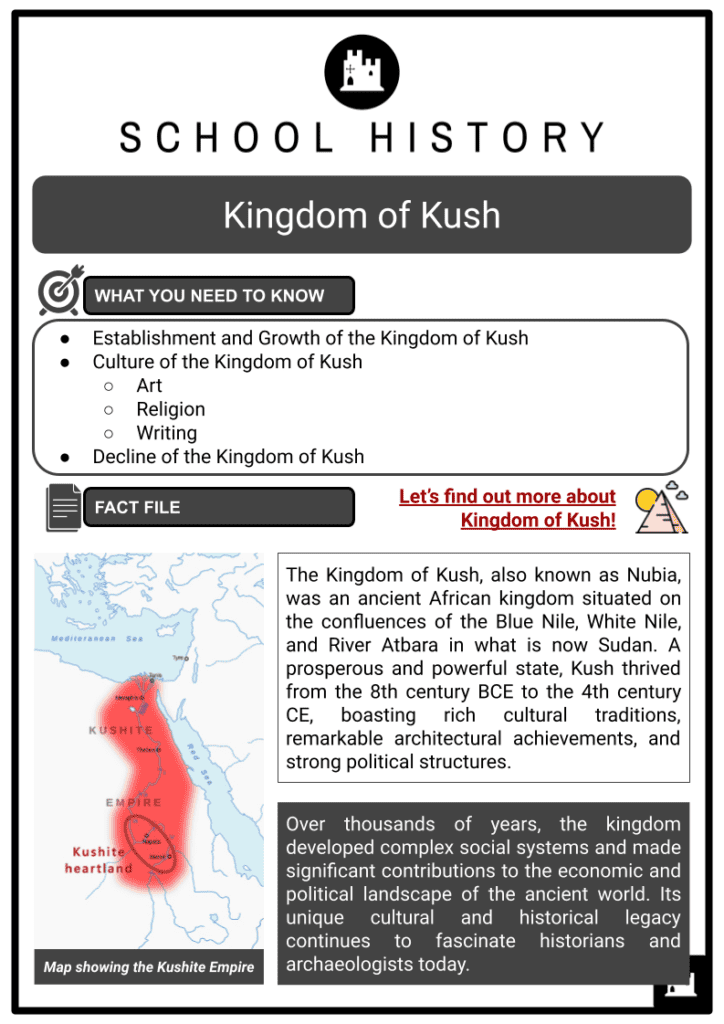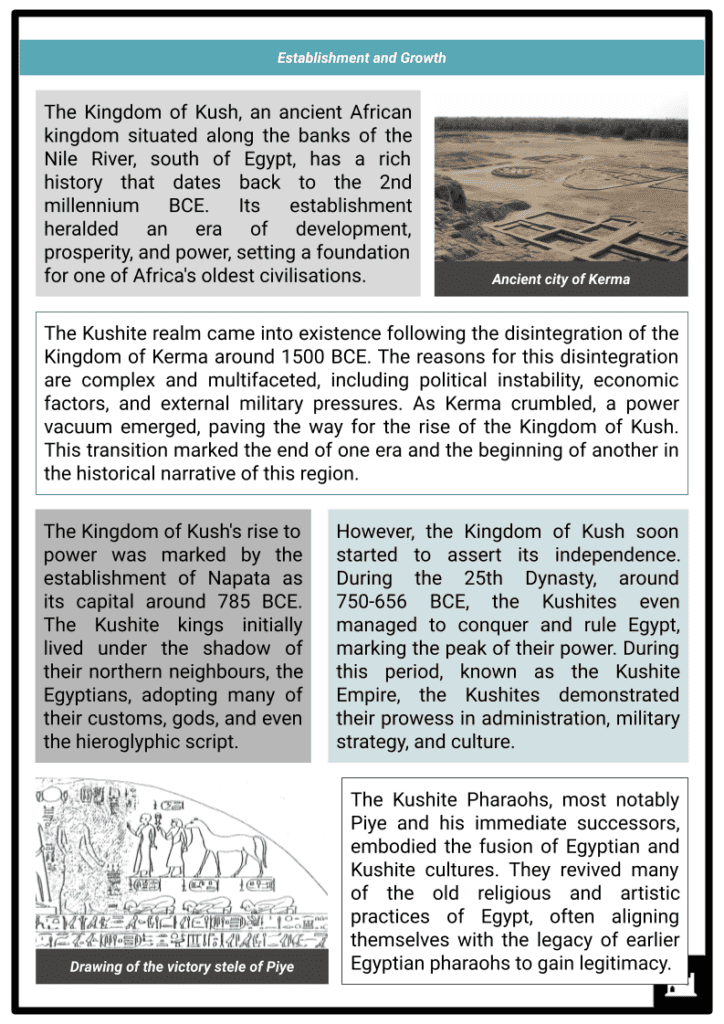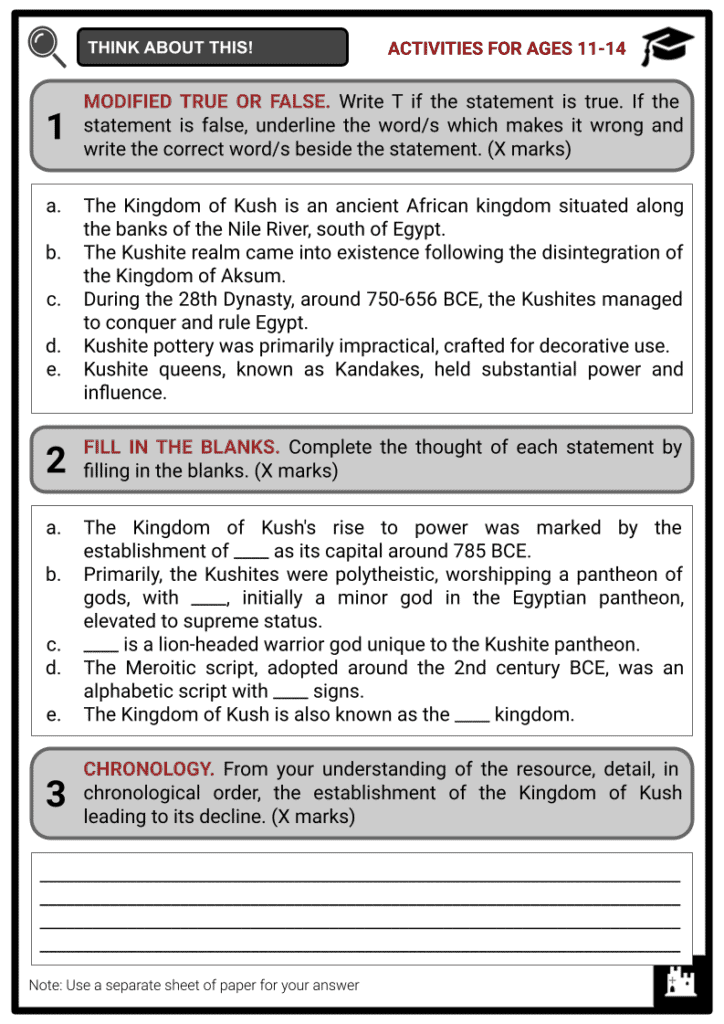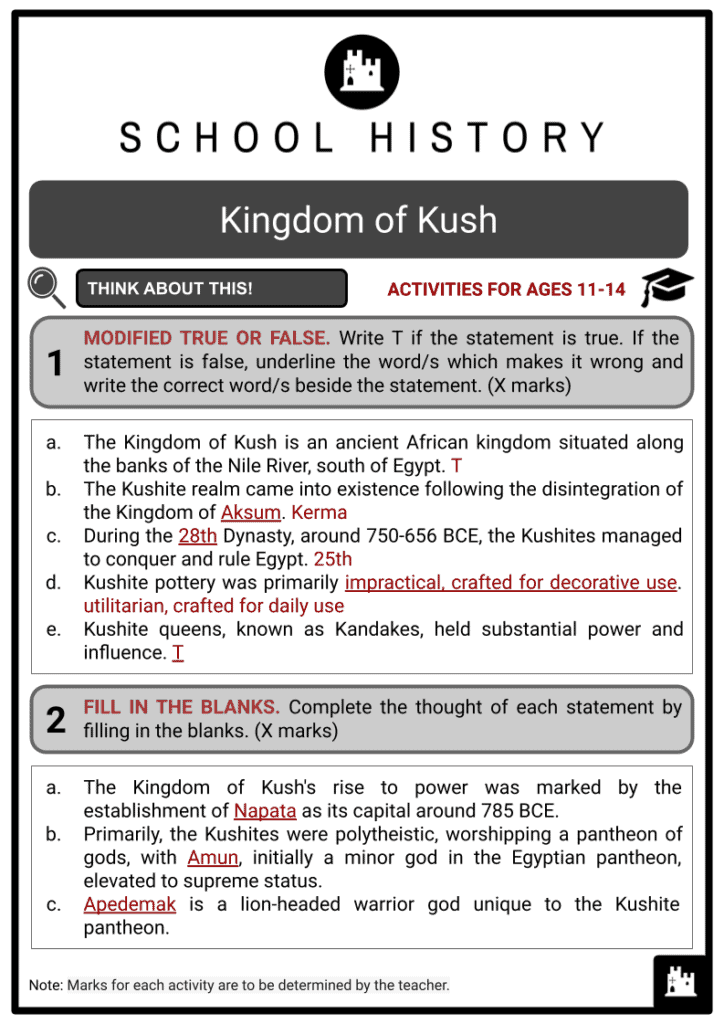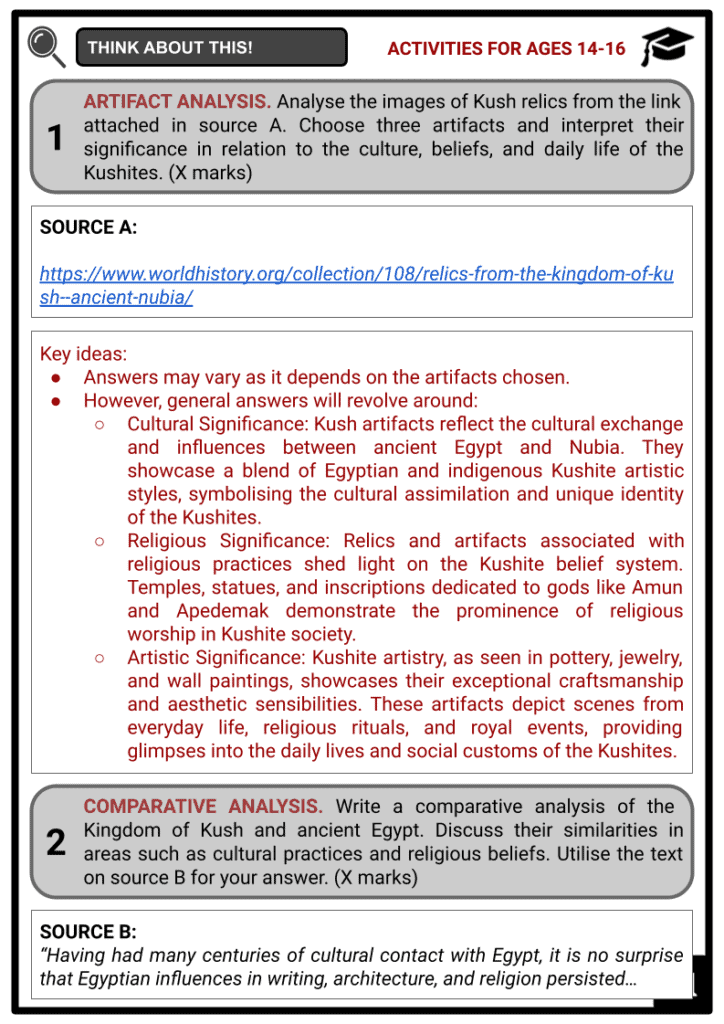Kingdom of Kush Worksheets
Do you want to save dozens of hours in time? Get your evenings and weekends back? Be able to teach about the Kingdom of Kush to your students?
Our worksheet bundle includes a fact file and printable worksheets and student activities. Perfect for both the classroom and homeschooling!
Summary
- Establishment and Growth of the Kingdom of Kush
- Culture of the Kingdom of Kush
- Art
- Religion
- Writing
- Decline of the Kingdom of Kush
Key Facts And Information
Let’s find out more about the Kingdom of Kush!
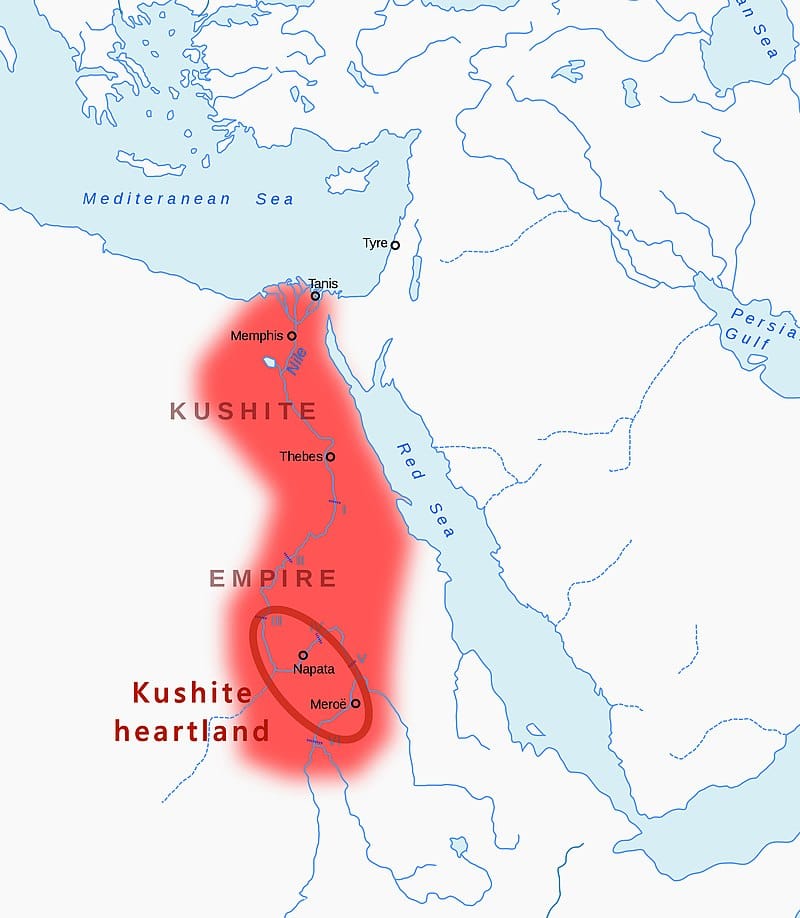
The Kingdom of Kush, also known as Nubia, was an ancient African kingdom situated on the confluences of the Blue Nile, White Nile, and River Atbara in what is now Sudan. A prosperous and powerful state, Kush thrived from the 8th century BCE to the 4th century CE, boasting rich cultural traditions, remarkable architectural achievements, and strong political structures. Over thousands of years, the kingdom developed complex social systems and made significant contributions to the economic and political landscape of the ancient world. Its unique cultural and historical legacy continues to fascinate historians and archaeologists today.
Establishment and Growth
- The Kingdom of Kush, an ancient African kingdom situated along the banks of the Nile River, south of Egypt, has a rich history that dates back to the 2nd millennium BCE. Its establishment heralded an era of development, prosperity, and power, setting a foundation for one of Africa's oldest civilisations.
- The Kushite realm came into existence following the disintegration of the Kingdom of Kerma around 1500 BCE. The reasons for this disintegration are complex and multifaceted, including political instability, economic factors, and external military pressures. As Kerma crumbled, a power vacuum emerged, paving the way for the rise of the Kingdom of Kush. This transition marked the end of one era and the beginning of another in the historical narrative of this region.
- The Kingdom of Kush's rise to power was marked by the establishment of Napata as its capital around 785 BCE. The Kushite kings initially lived under the shadow of their northern neighbours, the Egyptians, adopting many of their customs, gods, and even the hieroglyphic script.
- However, the Kingdom of Kush soon started to assert its independence. During the 25th Dynasty, around 750-656 BCE, the Kushites even managed to conquer and rule Egypt, marking the peak of their power. During this period, known as the Kushite Empire, the Kushites demonstrated their prowess in administration, military strategy, and culture.
- The Kushite Pharaohs, most notably Piye and his immediate successors, embodied the fusion of Egyptian and Kushite cultures. They revived many of the old religious and artistic practices of Egypt, often aligning themselves with the legacy of earlier Egyptian pharaohs to gain legitimacy.
- Their reign, however, was not without challenges. Assyrian invasions led by the formidable King Esarhaddon and his successor, Ashurbanipal, culminated in the Kushites being expelled from Egypt around 656 BCE.
- Despite this setback, the Kingdom of Kush continued to prosper. The capital was moved to Meroë, initiating what is known as the Meroitic period which spanned from around 300 BCE to 350 CE. This was a time of profound sociopolitical change, with the city of Meroë blossoming into a vibrant urban centre. Meroë was strategically located between the Nile and Atbara rivers, which fostered trade and economic prosperity.
- Regardless of pressures from the expanding Roman Empire and desertification, the Kingdom of Kush persisted for several centuries, displaying remarkable resilience and adaptability. Eventually, however, it was the rise of the Kingdom of Aksum in the 4th century CE that led to Kush's decline.
- The establishment and growth of the Kingdom of Kush reflect the resilience and resourcefulness of its people. From humble beginnings, they managed to carve out an empire, influence their powerful neighbours, and leave a lasting legacy in the annals of history.
Culture
- The culture of the Kingdom of Kush was a rich tapestry of art, religion, and writing, derived from a mix of indigenous traditions and Egyptian influences.
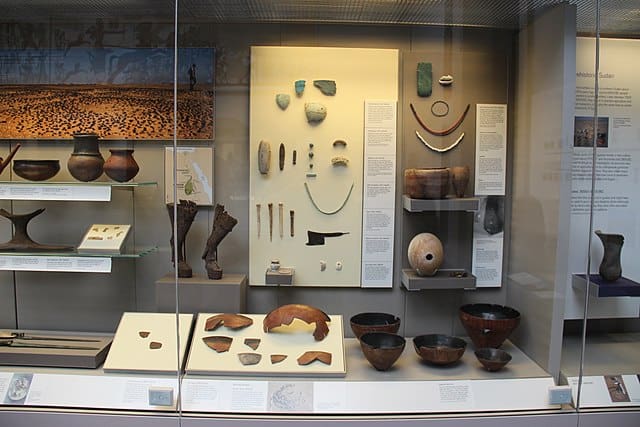
Kingdom of Kush artefacts - Despite the Egyptian influences, however, Kushite culture retained a distinct identity, reflecting the kingdom's resilience and its capacity to assimilate and adapt foreign elements into its indigenous context. This rich cultural heritage left a profound imprint on the region, the echoes of which can be found in the cultures of modern-day Sudan and South Sudan.
Art
- Artistically, the Kushites made significant strides in pottery, metalwork, and architecture. They developed a distinctive style of pottery, characterised by its black burnished surface and geometric designs.
- Kushite pottery was primarily utilitarian, crafted for daily use, but the skilled hands that moulded these wares transformed them into objects of beauty.
- These pieces often bore intricate geometric patterns that showcased the Kushites' artistic ingenuity. Pottery shapes generally included bowls, pots, and jars, with occasional figurines and ceremonial pieces.
- The forms and designs of the pottery also reflect cultural exchanges with neighbouring regions, providing valuable insights into the trade and social interactions of the time. The legacy of Kushite pottery lives on, influencing and inspiring modern ceramic traditions in the region.
- Kushite metalwork, particularly in iron and gold, was highly valued and traded across the ancient world. Iron was smelted for practical uses, like the creation of weapons and tools, while gold, abundant in the kingdom, was used for jewellery, statues, and embellishments on buildings.
- The Kushites' mastery of metalwork was not only central to their economic affluence but also a testament to their technological prowess. The intricate designs etched onto these metal pieces often depicted scenes from daily life, religious rituals, and royal iconography, offering a fascinating insight into Kushite society. This knowledge of ironworking was passed down through the generations and holds a significant influence on modern Sudanese metalworking practices.
- Architecturally, the Kushites are best known for their pyramids and temples. While these structures bear some resemblance to their Egyptian counterparts, they also showcase unique Kushite elements, such as the steep angles of their pyramids. They were also smaller, sharper, and more numerous than their Egyptian counterparts. Each pyramid was associated with a funerary chapel, adorned with carvings and inscriptions that provided valuable historical data.
- Temples in the Kingdom of Kush were grand structures, often constructed in honour of the gods. The Temple of Amun at Jebel Barkal, for instance, served as a significant religious and cultural hub.
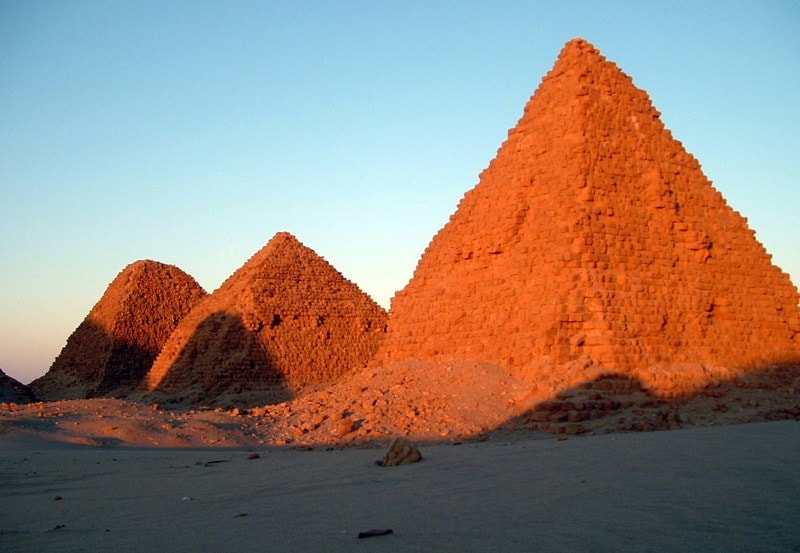
Kush pyramids - Meanwhile, the city of Meroë is particularly noted for its distinctive urban layout and architectural style. Unlike cities in contemporary kingdoms, Meroë was not built around a central plaza but rather oriented about the river Nile.
- Remarkably resilient structures such as the Lion Temple at Naqa, with its well-preserved bas-reliefs, bear testimony to the Kushites' advanced building techniques and their understanding of aesthetics. All these architectural accomplishments express a confluence of indigenous and external influences, embodying the Kushites' open and adaptive spirit.
Religion
- Religious belief in the Kingdom of Kush was a complex fusion of indigenous practices and borrowed motifs from Egypt, shaping a unique spiritual character that stood as a testament to Kushite syncretism. Primarily, the Kushites were polytheistic, worshipping a pantheon of gods, with Amun, initially a minor god in the Egyptian pantheon, elevated to supreme status.
- Amun was revered as a universal deity, symbolising the creative force of life. The Temple of Amun at Jebel Barkal was considered by the Kushites as the dwelling place of this god. This temple became a prime spiritual hub, a focal point for major religious ceremonies and royal coronations, reinforcing the intertwining of religion and state authority within Kushite society.
- Alongside Amun, the Kushites worshipped a variety of other deities, including Apedemak, a lion-headed warrior god unique to the Kushite pantheon. The Lion Temple at Naqa, dedicated to Apedemak, provides a glimpse into the Kushite's unique religious expressions, blending indigenous elements with borrowed iconography from Egypt.
- The Kushite afterlife beliefs and practices were also deeply influenced by the Egyptians. This is evident in the construction of pyramids as royal tombs, the mummification of bodies, and the provision of grave goods, all aimed to ensure a successful journey to the afterlife.
- A noteworthy aspect of the Kushite religion was the significant role women played in religious and political life. Unlike in many contemporary societies, Kushite queens, known as Kandakes, held substantial power and influence.
- Kandakes were often depicted in religious iconography, sometimes in the dominant position, highlighting the matrilineal aspects of Kushite society.
- The religion of the Kingdom of Kush was a vibrant and intrinsic aspect of its identity, showcasing the region's adaptability and openness to external influences while maintaining a distinct cultural essence.
Writing
- The art of writing in the Kingdom of Kush is a testament to their sophisticated civilisation and their interactions with other cultures, most notably Egypt. Rendered predominantly in the Meroitic script, the last stage of the kingdom's writing system, the Kushite inscriptions provide valuable insights into their society, religion, and politics.
- The Meroitic script, adopted around the 2nd century BCE, was an alphabetic script with 23 signs. Interestingly, it was written from right to left, reflecting its derivation from the Egyptian demotic script. However, unlike the logographic Egyptian script, the Meroitic was alphabetic, representing a significant departure and an indigenous adaptation.
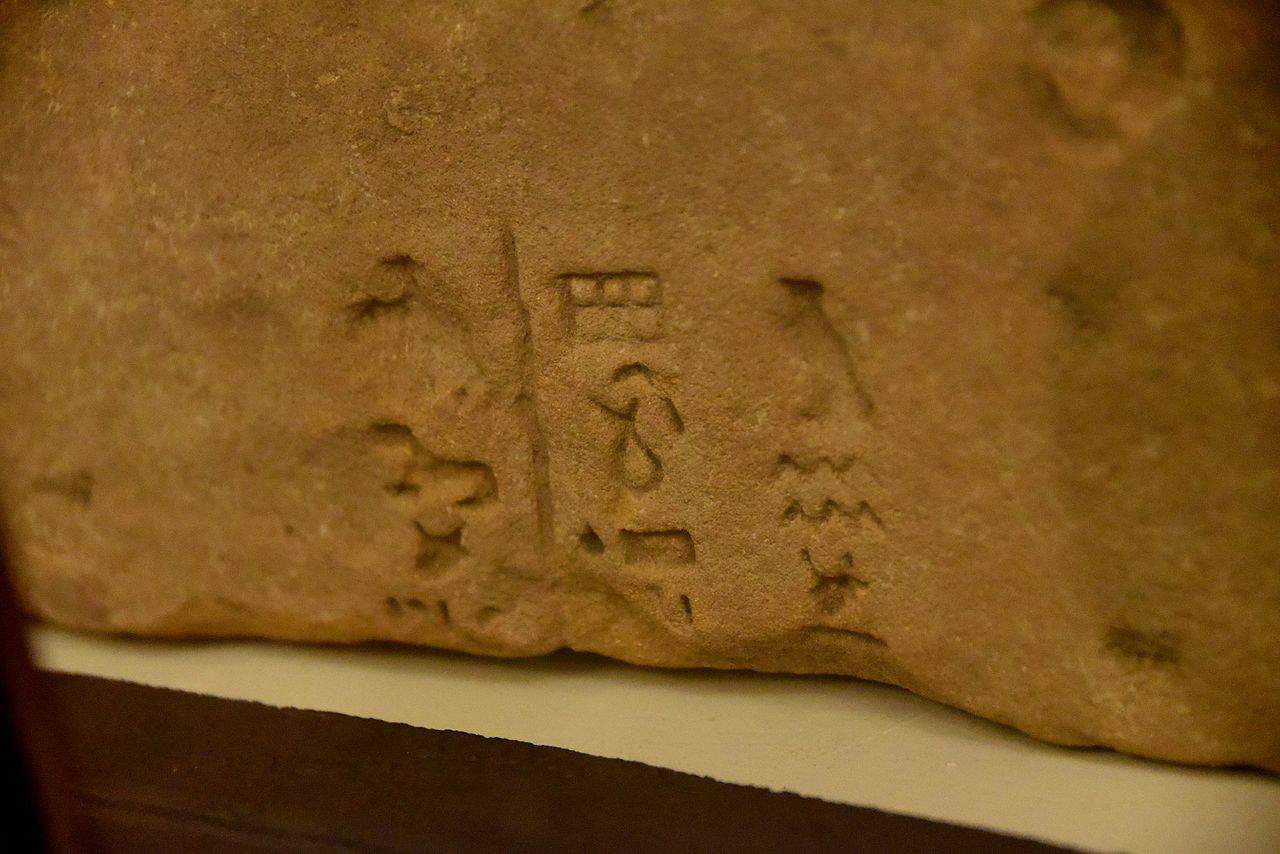
Detail of a sandstone showing Meroitic script - The use of this script was extensive, adorning temple walls, stelae, and royal pyramids. Royal annals and religious texts, inscribed meticulously, offer a glimpse into the Kushites' spiritual beliefs and their political milieu. Moreover, the presence of this script on everyday objects like pottery indicates its widespread use among the populace, suggesting a relatively high level of literacy.
- The Kushite writing demonstrates a complex interplay of indigenous and borrowed elements. While the script structure reveals Egyptian influence, the content, notably the names of gods and kings, reflects a strong Kushite identity. This balance highlights the kingdom's successful integration of external elements into its distinct cultural fabric.
- The art of writing in the Kingdom of Kush offers a unique lens to understand this ancient civilisation. It underscores their cultural sophistication, their interaction with Egypt, and their distinctive identity. The Meroitic script, while still largely undeciphered, stands as a symbol of their intellectual prowess and cultural achievement.
Decline
- The decline of the Kingdom of Kush, also known as the Nubian kingdom, was a seminal event in the annals of ancient history. A crucial player in international politics for nearly a millennium, the Kingdom of Kush's downfall was as versatile as its rise, marked by internal strife, external pressures, and environmental challenges.
- The first signs of decay emerged in the late 1st century CE when the kingdom started losing its foothold in Upper Egypt to the Roman Empire. The Roman annexation of Egypt introduced new trade routes that bypassed Kush, leading to economic stagnation. The ripple effects of this economic decline further destabilised the kingdom, limiting its ability to maintain its military might and fend off outside threats.
- Internally, the Kingdom of Kush grappled with political instability. The succession disputes among the Kushite royalty diluted the kingdom’s power and created divisions, making it an easy target for foreign invaders. This internal turbulence gradually eroded the kingdom's political and social structures, exacerbating the decline.
- Simultaneously, the kingdom faced environmental challenges. Persistent droughts, coupled with overuse of the land, resulted in significant agricultural decline. This ecological crisis undermined the kingdom's economy, which heavily relied on agriculture, and led to food shortages, further precipitating the decline.
- The Kingdom of Kush's fall was hastened by the rise of the Kingdom of Aksum to the south. By the 4th century CE, Aksum had emerged as a formidable power, challenging Kush's dominance. The Aksumite invasion in the 4th century marked the final blow to the already weakened Kush, leading to its eventual collapse.
- The decline of the Kingdom of Kush was a complex process driven by a combination of internal, external, and environmental factors. Despite its fall, the Kingdom of Kush left an unforgettable mark on history, its legacy visible in the ruins of Meroë and the undeciphered Meroitic script, symbols of a once mighty civilisation.
Image Sources
- https://upload.wikimedia.org/wikipedia/commons/thumb/0/07/Kushite_heartland_and_Kushite_Empire_of_the_25th_dynasty_circa_700_BCE.jpg/800px-Kushite_heartland_and_Kushite_Empire_of_the_25th_dynasty_circa_700_BCE.jpg
- https://upload.wikimedia.org/wikipedia/commons/thumb/9/92/Artifacts_from_Kingdom_of_Kush_%2835808395143%29.jpg/640px-Artifacts_from_Kingdom_of_Kush_%2835808395143%29.jpg
- https://upload.wikimedia.org/wikipedia/commons/e/ef/Pyramids_of_Nuri_%28cropped%29.jpg
- https://upload.wikimedia.org/wikipedia/commons/thumb/0/06/Detail_of_a_sandstone_showing_meroitic_hieroglyphs_in_3_vertical_columns%2C_probably_referring_to_Amun._From_Meroe._Meroitic_period._The_Petrie_Museum_of_Egyptian_Archaeology%2C_London.jpg/1280px-thumbnail.jpg
Frequently Asked Questions
- What was the Kingdom of Kush?
The Kingdom of Kush was an ancient civilisation in northeastern Africa's Nile Valley. It was one of the earliest and most powerful African civilisations, flourishing from around 1070 BCE to 350 CE.
- Where was the Kingdom of Kush located?
The Kingdom of Kush was located south of ancient Egypt, primarily in present-day Sudan and southern Egypt. Its capital city was Napata, which later shifted to Meroe.
- What were the major achievements of the Kingdom of Kush?
The Kingdom of Kush was known for its advanced civilisation, skilled metalworking, impressive architecture, and strong military. They also had a unique writing system known as Meroitic script.

